Sacred Temples – Hidden Messages (2)
Read the first part of the article
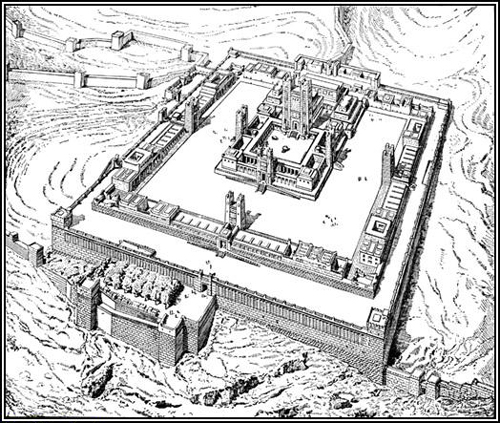
Ancient writings contain detailed descriptions of temples that were never discovered.
Have these temples ever existed?
What was the message encoded in their architecture and dimensions?
Ezekiel’s Vision of a Temple
(According to South Indian Temple Architecture)
by T.L.Subash Chandira Bose, Sthapathi V.Raman and Jack Andrews
Due to some specific reason the number seven was considered instead of six. We find in entire Holy Bible the number “Seven” play a vital role and also in all the religion and culture in the entire world, considered a Sacred Number in Ancient times.
Study on other linear measuring scale: An ancient linear measuring scale (1000 A.D), Ulagalantha kol (stick used to measure the world), with two plus (+) marks having total length of 128.5 inches was found at the tower of Vadavaraneswarar Temple, Thiruvalankadu by Dr. Kudavail Balasubramanian. The ancient inscription within the scale, describe that this scale was marked based on the scale in Rararajaeswarar (Big temple) temple situated at Thanjavur, Thanjavur district, Tamil Nadu.
Which is very close to Ezekiel’s linear measuring scale. Another scale with the measurement of 28.5 inches also found with extended plus (+) marks adjacent the main scale. If the main scale divided by four and a half, we find the result 28.55555556 inches, which is almost equal to 28.5 inches. Interestingly we shall find if the scale divided by 6 it is 21.4166667 inches (Ezekiel’s long cubit 21 inches).
An ancient linear measuring scale (800 A.D.) “Mannai ” (Mannai Kol) with two plus (+) marks having total length of 113.5 inches was found by one of the authors of this article Sthapathi V.Raman at Shree Kailasanathar temple situated at Alambakkam, Tiruchirapalli District. In the nearby stone inscription, a land of “Mannai Kol four and half” with this measurement land was measured and given as gift. So the actual measurement of the linear scale “Mannai” was 510.75 inches. Interestingly we shall find if the scale divided by 24 it is 21.28125 inches (Ezekiel’s long cubit 21 inches).
With the above reference we observe the linear scale shown in ancient period has to be multiplied with some factors for actual measurement.
Sacred Number Seven: There is an verse in Rig Veda book 10: “Purusa, who had a thousand heads, a thousand eyes, a thousand feet, investing the earth in all direction exceeds (it by a space) measuring ten fingers.”
Let us apply the factors used in Ezekiel’s scale, the “Seven” times of ten fingers and by “Six” times. The measurement of the reed would be 10 x 7 = 70 and 70x 6 = 420 fingers or 315 inches. Interestingly an ancient linear measuring scale (1200 A.D), Nilamalantha kol (stick used to measure the lands), with two plus (+) marks having total length of 157.5 inches was found by Dr. Kallaikovan in Thiruchendurai temple situated at Jeeya puram, Tiruchirapalli district, Tamil Nadu, India. We were surprised to observe 157.5 inches is half of 315 inches. Instead of ten fingers, if only five fingers are selected and the scale measurement will be (5×7=35, 35×6=210) 210 fingers or 157.5 inches.
Conclusion
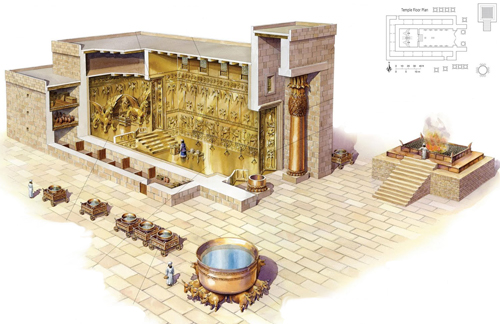
Purusa or man’s length as Unit of Measure: “In the construction of the fire altars, it has been customary in regards the man’s length as unit of measurement. All men are nit of equal stature, and hence the Yajamana or House-holder (the chief host in the sacrifice) was taken to be the standard for the sacrifice initiated by them.ˮ Geometry in Ancient India, Svami Satya Prakash Sarasvati, page 50.
The white elephant Iravatha was “seven Cubit” in height. Seventhi Puranam, verse. 314.
“The Great water (the Deep or Chaos) is said to be Seven Cubits deep” – “Therein, in the great mother, all the Gods, and the seven great ones are born.” (See chapter c viii. a, Book of the Dead and Egyptian Pantheon).
Ezekiel the linear measuring scale: The measurement of long cubit is “Seven” times of a handbreadth (7×4=28 fingers) and the reed is “Seven times of a cubit” (24×7=168 fingers).
We would like to conclude that, the “Purasa” (Divine man) with a standard length of six feet and the Sacred number Seven was considered in the selection of Ezekiel’s Linear measuring scale of a “Long Cubit” and a “Reed”, are “21” inches and “126” inches respectively.
This article is the beginning of unfolding the mystery on ancient linear measuring scale and not an end.
Solomon’s Temple
Solomon’s Temple is one of the most interpreted building in the history, and every architect saw its composition in a completely different way. Architects, mystics, Kings and fools, Templars, and Masons especially fantasized and fantasize about the nature, composition, meaning of this sacred building described in the Bible.
Many reasonable, but many more unreasonable suppositions have been made about the nature of the temple, and they have all in common a desire to invest a certain kind of meaning into described composition. If nothing else, Solomon’s Temple is a target of human desire par excellence.
Temple’s Description in the Bible
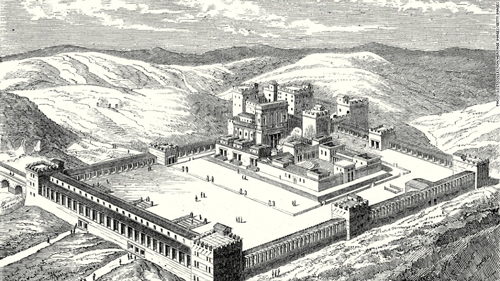
Preparations for Building the Temple
1 Kings 5
1. When Hiram king of Tyre heard that Solomon had been anointed king to succeed his father David, he sent his envoys to Solomon, because he had always been on friendly terms with David. 2. Solomon sent back this message to Hiram:
3. “You know that because of the wars waged against my father David from all sides, he could not build a temple for the Name of the LORD his God until the LORD put his enemies under his feet. 4. But now the LORD my God has given me rest on every side, and there is no adversary or disaster. 5. I intend, therefore, to build a temple for the Name of the LORD my God, as the LORD told my father David, when he said, ‘Your son whom I will put on the throne in your place will build the temple for my Name.’ˮ
6. “So give orders that cedars of Lebanon be cut for me. My men will work with yours, and I will pay you for your men whatever wages you set. You know that we have no one so skilled in felling timber as the Sidonians.”
7. When Hiram heard Solomon’s message, he was greatly pleased and said, “Praise be to the LORD today, for he has given David a wise son to rule over this great nation.”
8. So Hiram sent word to Solomon:
“I have received the message you sent me and will do all you want in providing the cedar and pine logs. 9. My men will haul them down from Lebanon to the sea, and I will float them in rafts by sea to the place you specify. There I will separate them and you can take them away. And you are to grant my wish by providing food for my royal household.”
10. In this way Hiram kept Solomon supplied with all the cedar and pine logs he wanted, 11. and Solomon gave Hiram twenty thousand cors of wheat as food for his household, in addition to twenty thousand baths, of pressed olive oil. Solomon continued to do this for Hiram year after year. 12. The LORD gave Solomon wisdom, just as he had promised him. There were peaceful relations between Hiram and Solomon, and the two of them made a treaty.
13. King Solomon conscripted laborers from all Israel-thirty thousand men. 14. He sent them off to Lebanon in shifts of ten thousand a month, so that they spent one month in Lebanon and two months at home. Adoniram was in charge of the forced labor.
15. Solomon had seventy thousand carriers and eighty thousand stonecutters in the hills, 16. as well as thirty-three hundred foremen who supervised the project and directed the workmen. 17. At the king’s command they removed from the quarry large blocks of quality stone to provide a foundation of dressed stone for the temple. 18. The craftsmen of Solomon and Hiram and the men of Gebal cut and prepared the timber and stone for the building of the temple.
Solomon Builds the Temple
1 Kings 6
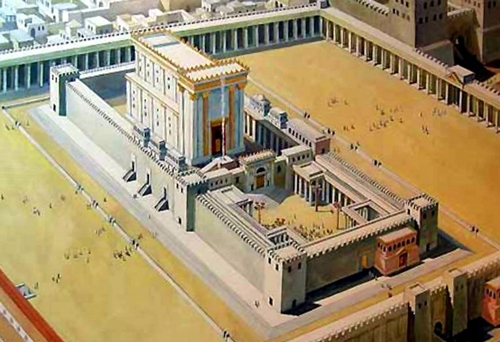
1. In the four hundred and eightieth year after the Israelites had come out of Egypt, in the fourth year of Solomon’s reign over Israel, in the month of Ziv, the second month, he began to build the temple of the LORD.
2. The temple that King Solomon built for the LORD was sixty cubits long, twenty wide and thirty high. 3. The portico at the front of the main hall of the temple extended the width of the temple, that is twenty cubits, and projected ten cubits from the front of the temple. 4. He made narrow clerestory windows in the temple. 5. Against the walls of the main hall and inner sanctuary he built a structure around the building, in which there were side rooms. 6. The lowest floor was five cubits wide, the middle floor six cubits and the third floor seven. He made offset ledges around the outside of the temple so that nothing would be inserted into the temple walls.
7. In building the temple, only blocks dressed at the quarry were used, and no hammer, chisel or any other iron tool was heard at the temple site while it was being built.
8. The entrance to the lowest floor was on the south side of the temple; a stairway led up to the middle level and from there to the third. 9. So he built the temple and completed it, roofing it with beams and cedar planks. 10. And he built the side rooms all along the temple. The height of each was five cubits, and they were attached to the temple by beams of cedar.
11. The word of the LORD came to Solomon: 12. “As for this temple you are building, if you follow my decrees, carry out my regulations and keep all my commands and obey them, I will fulfill through you the promise I gave to David your father. 13. And I will live among the Israelites and will not abandon my people Israel.”
14. So Solomon built the temple and completed it. 15. He lined its interior walls with cedar boards, paneling them from the floor of the temple to the ceiling, and covered the floor of the temple with planks of pine. 16. He partitioned off twenty cubits at the rear of the temple with cedar boards from floor to ceiling to form within the temple an inner sanctuary, the Most Holy Place. 17. The main hall in front of this room was forty cubits long. 18. The inside of the temple was cedar, carved with gourds and open flowers. Everything was cedar; no stone was to be seen.
19. He prepared the inner sanctuary within the temple to set the ark of the covenant of the LORD there. 20. The inner sanctuary was twenty cubits long, twenty wide and twenty high. He overlaid the inside with pure gold, and he also overlaid the altar of cedar. 21. Solomon covered the inside of the temple with pure gold, and he extended gold chains across the front of the inner sanctuary, which was overlaid with gold. 22. So he overlaid the whole interior with gold. He also overlaid with gold the altar that belonged to the inner sanctuary.
23. In the inner sanctuary he made a pair of cherubim of olive wood, each ten cubits high. 24. One wing of the first cherub was five cubits long, and the other wing five cubits-ten cubits from wing tip to wing tip. 25. The second cherub also measured ten cubits, for the two cherubim were identical in size and shape. 26. The height of each cherub was ten cubits. 27. He placed the cherubim inside the innermost room of the temple, with their wings spread out. The wing of one cherub touched one wall, while the wing of the other touched the other wall, and their wings touched each other in the middle of the room. 28. He overlaid the cherubim with gold.
29. On the walls all around the temple, in both the inner and outer rooms, he carved cherubim, palm trees and open flowers. 30. He also covered the floors of both the inner and outer rooms of the temple with gold.
31. For the entrance of the inner sanctuary he made doors of olive wood with five-sided jambs. 32. And on the two olive wood doors he carved cherubim, palm trees and open flowers, and overlaid the cherubim and palm trees with beaten gold. 33. In the same way he made four-sided jambs of olive wood for the entrance to the main hall. 34. He also made two pine doors, each having two leaves that turned in sockets. 35. He carved cherubim, palm trees and open flowers on them and overlaid them with gold hammered evenly over the carvings.
36. And he built the inner courtyard of three courses of dressed stone and one course of trimmed cedar beams.
37. The foundation of the temple of the LORD was laid in the fourth year, in the month of Ziv. 38. In the eleventh year in the month of Bul, the eighth month, the temple was finished in all its details according to its specifications. He had spent seven years building it.
Solomon Builds His Palace
1 Kings 7
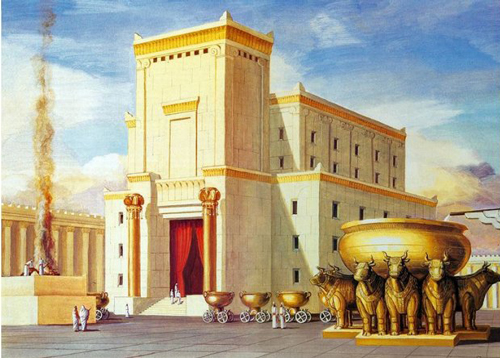
1. It took Solomon thirteen years, however, to complete the construction of his palace. 2. He built the Palace of the Forest of Lebanon a hundred cubits long, fifty wide and thirty high, with four rows of cedar columns supporting trimmed cedar beams. 3. It was roofed with cedar above the beams that rested on the columns-forty-five beams, fifteen to a row. 4. Its windows were placed high in sets of three, facing each other. 5. All the doorways had rectangular frames; they were in the front part in sets of three, facing each other.
6. He made a colonnade fifty cubits long and thirty wide. In front of it was a portico, and in front of that were pillars and an overhanging roof.
7. He built the throne hall, the Hall of Justice, where he was to judge, and he covered it with cedar from floor to ceiling. 8. And the palace in which he was to live, set farther back, was similar in design. Solomon also made a palace like this hall for Pharaoh’s daughter, whom he had married.
9. All these structures, from the outside to the great courtyard and from foundation to eaves, were made of blocks of high-grade stone cut to size and trimmed with a saw on their inner and outer faces. 10. The foundations were laid with large stones of good quality, some measuring ten cubits and some eight. 11. Above were high-grade stones, cut to size, and cedar beams. 12. The great courtyard was surrounded by a wall of three courses of dressed stone and one course of trimmed cedar beams, as was the inner courtyard of the temple of the LORD with its portico.
The Temple’s Furnishings
13. King Solomon sent to Tyre and brought Huram, 14. whose mother was a widow from the tribe of Naphtali and whose father was a man of Tyre and a craftsman in bronze. Huram was highly skilled and experienced in all kinds of bronze work. He came to King Solomon and did all the work assigned to him.
15. He cast two bronze pillars, each eighteen cubits high and twelve cubits around, by line. 16. He also made two capitals of cast bronze to set on the tops of the pillars; each capital was five cubits high. 17. A network of interwoven chains festooned the capitals on top of the pillars, seven for each capital. 18. He made pomegranates in two rows encircling each network to decorate the capitals on top of the pillars. He did the same for each capital. 19. The capitals on top of the pillars in the portico were in the shape of lilies, four cubits high. 20. On the capitals of both pillars, above the bowl-shaped part next to the network, were the two hundred pomegranates in rows all around. 21. He erected the pillars at the portico of the temple. The pillar to the south he named Jakin and the one to the north Boaz. 22. The capitals on top were in the shape of lilies. And so the work on the pillars was completed.
23. He made the Sea of cast metal, circular in shape, measuring ten cubits from rim to rim and five cubits high. It took a line of thirty cubits to measure around it. 24. Below the rim, gourds encircled it-ten to a cubit. The gourds were cast in two rows in one piece with the Sea.
25. The Sea stood on twelve bulls, three facing north, three facing west, three facing south and three facing east. The Sea rested on top of them, and their hindquarters were toward the center. 26. It was a handbreadth in thickness, and its rim was like the rim of a cup, like a lily blossom. It held two thousand baths.
27. He also made ten movable stands of bronze; each was four cubits long, four wide and three high. 28. This is how the stands were made: They had side panels attached to uprights. 29. On the panels between the uprights were lions, bulls and cherubim-and on the uprights as well. Above and below the lions and bulls were wreaths of hammered work. 30. Each stand had four bronze wheels with bronze axles, and each had a basin resting on four supports, cast with wreaths on each side. 31. On the inside of the stand there was an opening that had a circular frame one cubit deep. This opening was round, and with its basework it measured a cubit and a half. Around its opening there was engraving. The panels of the stands were square, not round. 32. The four wheels were under the panels, and the axles of the wheels were attached to the stand. The diameter of each wheel was a cubit and a half. 33. The wheels were made like chariot wheels; the axles, rims, spokes and hubs were all of cast metal.
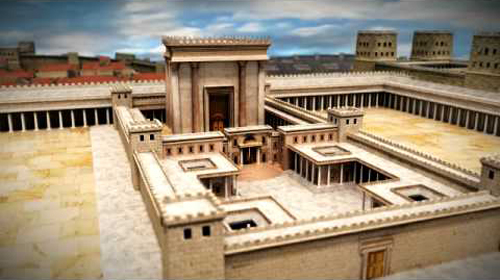
34. Each stand had four handles, one on each corner, projecting from the stand. 35. At the top of the stand there was a circular band half a cubit deep. The supports and panels were attached to the top of the stand. 36. He engraved cherubim, lions and palm trees on the surfaces of the supports and on the panels, in every available space, with wreaths all around. 37. This is the way he made the ten stands. They were all cast in the same molds and were identical in size and shape.
38. He then made ten bronze basins, each holding forty baths and measuring four cubits across, one basin to go on each of the ten stands. 39. He placed five of the stands on the south side of the temple and five on the north. He placed the Sea on the south side, at the southeast corner of the temple. 40. He also made the basins and shovels and sprinkling bowls.
So Huram finished all the work he had undertaken for King Solomon in the temple of the LORD:
41. the two pillars;
the two bowl-shaped capitals on top of the pillars;
the two sets of network decorating the two bowl-shaped capitals on top of the pillars;
42. the four hundred pomegranates for the two sets of network (two rows of pomegranates for each network, decorating the bowl-shaped capitals on top of the pillars);
43. the ten stands with their ten basins;
44. the Sea and the twelve bulls under it;
45. the pots, shovels and sprinkling bowls.
All these objects that Huram made for King Solomon for the temple of the LORD were of burnished bronze. 46. The king had them cast in clay molds in the plain of the Jordan between Succoth and Zarethan. 47. Solomon left all these things unweighed, because there were so many; the weight of the bronze was not determined.
48. Solomon also made all the furnishings that were in the LORD’s temple:
the golden altar;
the golden table on which was the bread of the Presence;
49. the lampstands of pure gold (five on the right and five on the left, in front of the inner sanctuary);
the gold floral work and lamps and tongs;
50. the pure gold basins, wick trimmers, sprinkling bowls, dishes and censers;
and the gold sockets for the doors of the innermost room, the Most Holy Place, and also for the doors of the main hall of the temple.
51. When all the work King Solomon had done for the temple of the LORD was finished, he brought in the things his father David had dedicated-the silver and gold and the furnishings-and he placed them in the treasuries of the LORD’s temple.
Read the third part of the article
yogaesoteric
March 17, 2019
